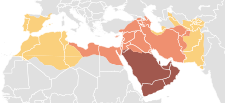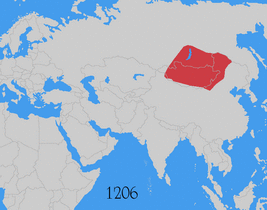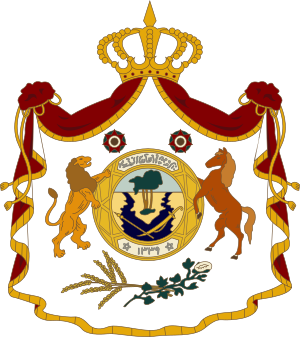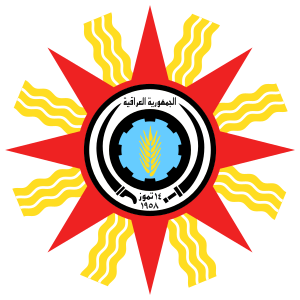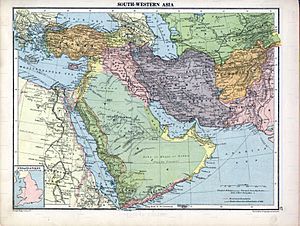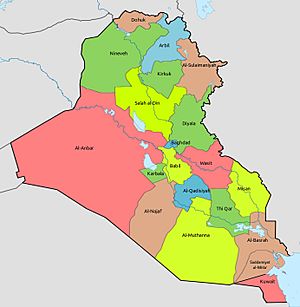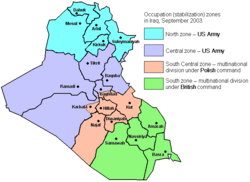History of Iraq facts for kids
Iraq is a country in Western Asia. It is mostly the same land as ancient Mesopotamia. The history of Mesopotamia goes back to the Stone Age. It continued until the 600s AD, when the area became known as Iraq.
Inside Iraq, you'll find the ancient land of Sumer. This civilization started between 6000 and 5000 BC. Many people think Sumer is the oldest civilization we know about. Iraq was also home to powerful empires like the Akkadian, Neo-Sumerian, Babylonian, Neo-Assyrian, and Neo-Babylonian empires. These empires ruled Mesopotamia and other parts of the Ancient Near East during the Bronze and Iron Ages.
Long ago, Iraq was a place where many important things began. This includes some of the world's first writing, stories, sciences, math, laws, and ideas. That's why it's often called the Cradle of Civilization.
This time of self-rule ended in 539 BC. The Neo-Babylonian Empire was taken over by the Achaemenid Empire led by Cyrus the Great. He called himself "King of Babylon". The ancient city of Babylon became a very important capital for the Achaemenid Empire.
Over the next 700 years, the lands that are now Iraq were ruled by Greeks, Parthians, and Romans. The Greeks and Parthians even built new capital cities there. By the 3rd century AD, the area was again under Persian (Sasanian) control. Around this time, nomadic Arab tribes from South Arabia (modern-day Yemen) started moving into Lower Mesopotamia. This led to the creation of the Lakhmid Kingdom around 300 AD. The Arabic name al-ʿIrāq comes from this period.
The Sasanian Empire was later conquered by the Rashidun Caliphate in the 600s. Iraq came under Islamic rule after the Battle of al-Qadisiyyah in 636. The city of Kufa was founded soon after and became the home of the Rashidun rulers. When the Abbasids rose to power in 750, Iraq became the center of their rule. First in Kufa, then Anbar, and finally in Baghdad after it was built in 762. Baghdad was the capital for most of the Abbasid Caliphate's time. It became the world's cultural and intellectual center during the Islamic Golden Age.
Baghdad grew quickly in the 800s. But then it faced problems in the 900s due to invasions by the Buwayhid and Seljuq groups. It remained important until the Mongol invasion in 1258. After this, Iraq became a province of the Turco-Mongol Ilkhanate and lost some of its importance. Later, it was ruled by the Jalairids and Kara Koyunlu. In the 1500s, it became part of the Ottoman Empire. Sometimes, it was also controlled by the Iranian Safavids and Mamluks.
Ottoman rule ended after World War I. Then, the British Empire managed Mandatory Iraq. There was also a Hashemite monarchy led by King Faisal I. The Kingdom of Iraq became fully independent in 1932. This happened under the Anglo-Iraqi Treaty. A republic was formed in 1958 after a coup. Saddam Hussein ruled from 1968 to 2003. During his time, there was the Iran–Iraq War and the Gulf War. Saddam Hussein was removed from power after the U.S. invasion in 2003.
Contents
Ancient History of Iraq
Early Human Life
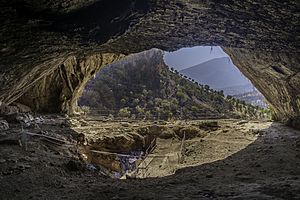
From 1957 to 1961, scientists explored Shanidar Cave. They found nine skeletons of Neanderthals. These remains were from 60,000 to 80,000 years ago. One more Neanderthal was found later. These findings suggest that Neanderthals might have had funeral ceremonies. They may have buried their dead with flowers. It also seems they cared for injured and elderly people.
Mesopotamia is where the Neolithic Revolution began around 10,000 BC. This was a time of big changes for humans. It led to important inventions like the wheel. People also started planting the first crops. They developed writing, math, astronomy, and farming.
Bronze Age Empires
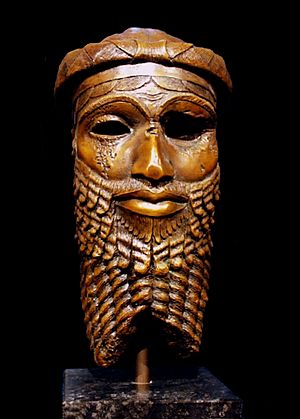
Sumer developed in Lower Mesopotamia during the prehistoric Ubaid period. This was in the mid-6th millennium BC. It continued into the Early Bronze Age (Uruk period). Sumerian civilization ended when the Akkadian Empire rose in the 24th century BC. After a period called the Gutian period, the Ur III kingdom brought parts of southern and central Mesopotamia together again. This was in the 21st century BC. It might have fallen apart due to Amorite attacks. The Amorite dynasty of Isin lasted until about 1600 BC. Then, southern Mesopotamia was united under Kassite Babylonian rule.
Northern Mesopotamia became the Akkadian-speaking state of Assyria. This happened by the late 25th century BC. Like the rest of Mesopotamia, it was ruled by Akkadian kings. This was from the late 24th to mid-22nd centuries BC. After that, Assyria became independent again.
Babylonia was a state in Lower Mesopotamia. Its capital was Babylon. An Amorite king named Sumuabum founded it as an independent state in 1894 BC. Akkadian slowly replaced Sumerian as the main language in Mesopotamia. This happened around 2000 BC. But Sumerian was still used for writing and ceremonies for a long time.
Babylonia grew strong under the Amorite dynasties around 1900 BC. Hammurabi (around 1792–1750 BC) united the lands of Sumer and Akkad. In the early Amorite period, the most powerful cities were Isin and Larsa. Shamshi-Adad I almost united the northern areas around Assur and Mari. One Amorite family started a dynasty in Babylon. This city eventually took over the others. This formed the first Babylonian empire.
Assyria was an Akkadian kingdom in Upper Mesopotamia. It became a major empire several times. It was named after its first capital, the ancient city of Assur. We don't know much about the very early history of Assyria. The first king listed was Tudiya. He lived around the late 25th or early 24th century BC. The first true Assyrian monarchy was traditionally started by Ushpia around 2030 BC.
Assyria was an empire from the 19th to 18th centuries BC. From the 14th to 11th centuries BC, Assyria became a major power again. This was with the rise of the Middle Assyrian Empire.
Iron Age Empires
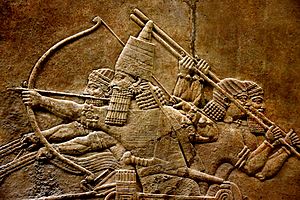
The Neo-Assyrian Empire (911–609 BC) was the strongest power in the Ancient Near East during the Iron Age. It was more powerful than Babylonia, Egypt, Urartu, and Elam. During this time, Aramaic became an official language of the empire, along with Akkadian.
The Neo-Babylonian Empire (626–539 BC) was the last major empire before the Persian conquest. After the last strong Assyrian ruler, Assurbanipal, died in 627 BC, the Assyrian empire had many civil wars. Babylonia rebelled under Nabopolassar. He was from the Chaldean tribe. They had moved to southeastern Babylonia in the early 800s BC. Nabopolassar teamed up with the Medes, Persians, Scythians, and Cimmerians. They attacked and destroyed the city of Nineveh in 612 BC. Power then shifted to Babylonia. This was the first time since Hammurabi's death in the 1700s BC. This period saw better economic life and farming. There was also a great boom in building, arts, and science.
The Neo-Babylonian period ended with the rule of Nabonidus in 539 BC. To the east, the Persians were growing stronger. Eventually, Cyrus the Great took control of Babylon.
-
The Assyrian Empire at its greatest extent
-
The Neo-Babylonian Empire at its greatest extent
Iraq in Ancient Times
Persian and Greek Rule
The Achaemenid Persians conquered Mesopotamia in 539 BC. This was under Cyrus the Great. The region stayed under Persian rule for two centuries.
The Persian Empire fell to Alexander of Macedon in 331 BC. It then came under Greek rule as part of the Seleucid Empire. The city of Babylon became less important after Seleucia on the Tigris was founded. Seleucia became the new capital of the Seleucid Empire. At its strongest, the Seleucid Empire stretched from the Aegean Sea in the west to India in the east. It was a big center for Hellenistic culture. Greek customs were very important, and a Greek ruling class was in charge, mostly in cities. More Greeks moved from Greece to strengthen this elite.
Much of the eastern part of the empire was conquered by the Parthians. This happened under Mithridates I of Parthia in the mid-2nd century BC.
Parthian and Roman Rule
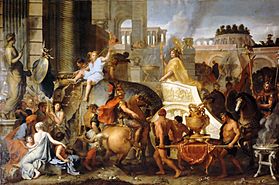
In the early 2nd century AD, the Romans invaded Parthia. Emperor Trajan led them. They conquered Mesopotamia and made it a Roman province. But Trajan's successor, Hadrian, soon gave it back to the Parthians.
Christianity arrived in Mesopotamia in the 1st century AD. Roman Syria became a center for Eastern Rite Christianity. It also became important for the Syriac writing tradition. Mandeism is also thought to have started there around this time. Or Mandaeans might have moved there to find safety.
Sumerian-Akkadian religious traditions disappeared during this period. The last people who could read cuneiform writing also vanished. However, temples were still dedicated to the Assyrian god Ashur in his home city as late as the 300s AD.
Sasanian Empire
In the 3rd century AD, the Sassanid dynasty took over from the Parthians. They ruled Mesopotamia until the Islamic invasion in the 600s. The Sasanids conquered the independent states of Adiabene, Osroene, Hatra, and finally Assur in the 3rd century. In the mid-6th century, the Persian Empire was divided into four parts by Khosrow I. The western part, called Khvārvarān, included most of modern Iraq. It was further divided into provinces like Mishān, Asuristān (Assyria), Adiabene, and Lower Media. The term Iraq was widely used in medieval Arabic writings for the central and southern areas of the modern republic. It was a geographic term, not a political one.
Many Arabs moved into the area during the Sasanian period. Upper Mesopotamia became known as Al-Jazirah in Arabic. This means "The Island," referring to the land between the Tigris and Euphrates rivers. Lower Mesopotamia became known as ʿIrāq-i ʿArab. This means "the escarpment of the Arabs."
Until 602, the desert border of the Persian Empire was protected by the Arab Lakhmid kings of Al-Hirah. That year, Shahanshah Khosrow II abolished the Lakhmid kingdom. This left the border open to attacks from nomads. Further north, the western part bordered the Byzantine Empire. The border generally followed the modern Syria-Iraq border. It continued north, passing between Nisibis (modern Nusaybin) as the Sasanian border fort and Dara and Amida (modern Diyarbakır) held by the Byzantines.
Iraq in the Middle Ages
Islamic Conquest

The first major fight between invading Arab tribes and Persian forces in Mesopotamia was in 634. The Arabs were defeated at the Battle of the Bridge. About 5,000 Muslims were routed by the Persians. After this, Khalid ibn al-Walid led a successful campaign. All of Iraq came under Arab rule within a year, except for the Persian capital, Ctesiphon. Around 636, a larger Arab Muslim army defeated the main Persian army at the Battle of al-Qādisiyyah. They then captured the Persian capital of Ctesiphon. By the end of 638, the Muslims had conquered all the western Sasanian provinces, including modern Iraq. The last Sasanian Emperor, Yazdegerd III, fled and was killed in 651.
The Islamic expansions were the largest movements of Semitic peoples in history. These new arrivals did not spread out everywhere. Instead, they built two new military cities. One was at al-Kūfah, near ancient Babylon. The other was at Basrah in the south. The north remained mostly Assyrian and Arab Christian.
Abbasid Caliphate
The city of Baghdad was built in the 700s. It became the capital of the Abbasid Caliphate. Baghdad quickly became the main cultural center of the Muslim world. This was during the "Islamic Golden Age" in the 700s and 800s.
In the 800s, the Abbasid Caliphate started to decline. From the late 800s to early 1000s, parts of Iraq were ruled by smaller Iranian groups. These included the Tahirids, Saffarids, Samanids, Buyids, and Sallarids. Tughril, who founded the Seljuk Empire, captured Baghdad in 1055. Even though they lost power, the Abbasid caliphs still had a grand court in Baghdad. They remained important in religious matters. They upheld the beliefs of their Sunni branch of Islam against the Ismaili and Shia branches.
Mongol Invasion
In the late 1000s, Iraq came under the rule of the Khwarazmian dynasty. Both Turkic and Abbasid rule ended with the Mongol invasions in the 1200s. The Mongols, led by Genghis Khan, had conquered Khwarezmia by 1221. But Iraq got a break because Genghis Khan died in 1227. This led to power struggles among the Mongols.
Möngke Khan started a new expansion of the Mongol Empire in 1251. When caliph al-Mustasim refused to surrender, Hulagu Khan attacked and captured Baghdad in 1258. After destroying the Abbasid Caliphate, Hulagu could move into Syria. He then attacked other Muslim powers in the region.
Turco-Mongol Rule
Iraq became a province on the edge of the Ilkhanate. Baghdad never regained its former importance.
The Jalayirids were a Mongol dynasty. They ruled over Iraq and western Persia after the Ilkhanate broke up in the 1330s. The Jalayirid sultanate lasted about fifty years. It was then disrupted by Tamerlane's conquests. Rebellions by the "Black Sheep Turks" or Qara Qoyunlu also caused problems. After Tamerlane died in 1405, there was a short attempt to bring back the sultanate in southern Iraq. The Jalayirids were finally defeated by Kara Koyunlu in 1432.
Ottoman and Mamluk Rule
In the late 1300s and early 1400s, the Black Sheep Turkmen ruled the area now known as Iraq. In 1466, the White Sheep Turkmen defeated the Black Sheep and took control. Later, the White Sheep were defeated by the Safavids. The Safavids controlled Mesopotamia for some time. In the 1500s, most of present-day Iraq came under the control of the Ottoman Empire. It became the pashalik of Baghdad. For most of Ottoman rule (1533–1918), Iraq was a battleground. Different empires and tribal groups fought there.
Iraq was divided into three main areas called vilayets:
- Mosul Province
- Baghdad Province
- Basra Province
The Safavid dynasty of Iran briefly controlled Iraq from 1508–1533 and 1622–1638. From 1747–1831, Iraq was ruled by Mamluk officers from Georgia. They managed to gain some independence from the Ottoman Empire. They stopped tribal revolts and reduced the power of the Janissaries. They brought back order and started modernizing the economy and military. In 1831, the Ottomans managed to overthrow the Mamluk rule. They took direct control over Iraq again.
Iraq in the 20th Century
British Control
Ottoman rule over Iraq ended with World War I. The Ottomans sided with Germany and the Central Powers. In the Mesopotamian campaign against the Central Powers, British forces invaded Iraq. They suffered a defeat at the Siege of Kut (1915–16). However, the British eventually won the Mesopotamian Campaign. They captured Baghdad in March 1917. During the war, the British used help from Assyrian, Armenian, and Arab tribes against the Ottomans. The Ottomans, in turn, used Kurds as allies. After the war, the Ottoman Empire was divided. The British Mandate of Mesopotamia was set up by the League of Nations mandate.
Britain put a Hāshimite monarchy in charge of Iraq. They set Iraq's borders without considering the different ethnic and religious groups. This was especially true for the Kurds and Christian Assyrians in the north. During the British occupation, the Kurds fought for independence. The British used Assyrian Levies to help stop these uprisings. Iraq also became a government ruled by a small group of powerful people at this time.
King Faisal I of Iraq was officially made king after a vote on August 23, 1921. The country's name also changed from Mesopotamia to Iraq. Iraq gained full independence in 1932, when the British Mandate officially ended.
Independent Kingdom of Iraq
After Arab Sunni rule was established in Iraq, there were uprisings. These included Assyrian, Yazidi, and Shi'a unrests. All of these were put down harshly. In 1936, the first military coup happened in Iraq. Bakr Sidqi managed to replace the Prime Minister. Many coups followed in a time of political instability. This peaked in 1941.
During World War II, Iraq's government was overthrown in 1941. This was done by the Golden Square officers, led by Rashid Ali. The short-lived pro-Nazi government was defeated in May 1941. This was by allied forces, with local Assyrian and Kurdish help. Iraq was later used as a base for allied attacks on French-held Mandate of Syria. It also supported the Anglo-Soviet invasion of Iran.
In 1945, Iraq joined the United Nations. It also became a founding member of the Arab League. At the same time, the Kurdish leader Mustafa Barzani led a rebellion against the government in Baghdad. After the uprising failed, Barzani and his followers fled to the Soviet Union.
In 1948, large, violent protests happened in Baghdad. These were called the Al-Wathbah uprising. They had some communist support. People protested against the government's treaty with Britain. Protests continued into spring. They stopped in May when martial law was declared. This was because Iraq entered the failed 1948 Arab–Israeli War with other Arab League members.
In February 1958, King Hussein of Jordan and `Abd al-Ilāh suggested a union of Hashemite monarchies. This was to counter the new Egyptian-Syrian union. The prime minister Nuri as-Said wanted Kuwait to be part of this union. This plan caused conflict between Iraq and Britain. Britain did not want Kuwait to be independent. At this point, the monarchy was completely alone. Nuri as-Said could only control the growing unhappiness by using even more political oppression.
Republic of Iraq
Inspired by Gamal Abdel Nasser of Egypt, officers from the Nineteenth Brigade overthrew the Hashemite monarchy. This happened on July 14, 1958. Brigadier Abd al-Karīm Qāsim led them. The new government declared Iraq a republic. It rejected the idea of uniting with Jordan. Iraq stopped its activities in the Baghdad Pact.
Abd al-Karim Qasim promoted a sense of Iraqi national pride. He believed that Iraqis are one nation. He supported the cultural unity of Iraqis from different groups. This included Mesopotamian Arabs, Kurds, Turkmens, Assyrians, Chaldeans, Yazidis, Mandeans, Yarsans, and others.
Qasim's idea of nationalism included recognizing an Iraqi identity. This identity came from ancient Mesopotamia. It included its civilizations of Sumer, Akkad, Babylonia, and Assyria.
In 1961, Kuwait became independent from Britain. Iraq then claimed Kuwait as its own. A period of great instability followed.
In the same year, Mustafa Barzani started fighting Iraqi government forces. He had been invited back to Iraq by Qasim three years earlier. This was the start of the First Kurdish Iraqi War. Barzani began to establish Kurdish control in the north.
Ba'athist Iraq

Qāsim was killed in February 1963. The Ba'ath Party took power. General Ahmed Hassan al-Bakr became prime minister. Colonel Abdul Salam Arif became president. In June 1963, Syria, also under Ba'athist rule, joined Iraq's military campaign against the Kurds. They provided aircraft, armored vehicles, and 6,000 soldiers. Several months later, `Abd as-Salam Muhammad `Arif led a successful coup against the Ba'ath government. Arif declared a ceasefire in February 1964. This caused a split among Kurdish groups.
On April 13, 1966, President Abdul Salam Arif died in a helicopter crash. His brother, General Abdul Rahman Arif, took over. After this, the Iraqi government tried one last time to defeat the Kurds. This failed in May 1966. Barzani's forces completely defeated the Iraqi Army at the Battle of Mount Handrin. After the Six-Day War in 1967, the Ba'ath Party felt strong enough to take power again in 1968. Ahmed Hassan al-Bakr became president. The Ba'ath government started a campaign to end the Kurdish uprising. This stalled in 1969. This was partly due to power struggles in Baghdad and tensions with Iran. Also, the Soviet Union pressured Iraq to make peace with Barzani. The war ended with over 100,000 deaths. Neither the Kurdish rebels nor the Iraqi government gained much.
After the First Kurdish Iraqi War, a peace plan was announced in March 1970. It offered more self-rule for Kurds. The plan also gave Kurds a voice in government. This was to be put in place in four years. Despite this, the Iraqi government started a program to make oil-rich areas more Arab. This was in Kirkuk and Khanaqin. In the following years, Baghdad solved its internal problems. It signed a friendship treaty with the Soviet Union in April 1972. This ended its isolation in the Arab world. On the other hand, Kurds still relied on Iranian military support. They could not strengthen their forces much. By 1974, the situation in the north worsened again. This led to the Second Kurdish Iraqi War, which lasted until 1975.
Under Saddam Hussein
In July 1979, President Ahmed Hassan al-Bakr was forced to resign by Saddam Hussein. Saddam became both President and Chairman of the Revolutionary Command Council. Saddam then removed his opponents, even those from within the Ba'ath party.
- Iraq's Claims to Neighboring Lands
Iraq's claims to neighboring countries were largely due to plans from 1919–1920. At that time, the Ottoman Empire was divided. There were promises to create a larger Arab state in Iraq and the Jazeera. This state would include parts of eastern Syria, southeastern Turkey, all of Kuwait, and Iran’s border areas. This is shown on an English map from 1920.
Disputes over land with Iran led to a costly eight-year war. This was the Iran–Iraq War (1980–1988). Iraq called it Qādisiyyat-Saddām. The war badly damaged the economy. Iraq falsely claimed victory in 1988. But it was just a return to how things were before the war. Both sides kept their original borders.
The war started when Iraq invaded Iran on September 22, 1980. This followed a long history of border disputes. Iraq also feared a Shia uprising among its Shia majority. This was influenced by the Iranian Revolution. Iraq also wanted to become the main power in the Persian Gulf. The United States supported Saddam Hussein in the war against Iran. Iraq hoped to take advantage of the chaos in Iran. They attacked without warning. But they only made limited progress into Iran. Within months, the Iranians pushed them back. By June 1982, Iran had regained almost all lost land. For the next six years, Iran was on the attack. Despite calls for a ceasefire by the United Nations Security Council, fighting continued until August 20, 1988. The war finally ended with a UN-brokered ceasefire. This was United Nations Security Council Resolution 598. Both sides accepted it. It took several weeks for Iranian forces to leave Iraqi territory. They honored the pre-war international borders. The last prisoners of war were exchanged in 2003.
The war cost many lives and caused huge economic damage. Half a million Iraqi and Iranian soldiers and civilians died. Many more were injured. But it brought no payments or border changes. The conflict is often compared to World War I. The tactics used were very similar. This included large-scale trench warfare, machine-gun posts, and bayonet charges. They also used barbed wire across trenches and human wave attacks across no-man's land. Iraq also used chemical weapons like mustard gas against Iranian troops and civilians. They also used them against Iraqi Kurds. At the time, the UN Security Council said that "chemical weapons had been used." However, these UN statements did not clearly say that only Iraq was using chemical weapons.
A long-standing land dispute was the reason for Iraq's invasion of Kuwait in 1990. In November 1990, the UN Security Council passed Resolution 678. This allowed member states to use all necessary means. It authorized military action against Iraqi forces in Kuwait. It demanded a full withdrawal by January 15, 1991. When Saddam Hussein did not obey, the Gulf War (Operation "Desert Storm") began on January 17, 1991. Estimates say between 1,500 and 30,000 Iraqi soldiers were killed. Less than a thousand civilians also died.
In March 1991, revolts started in southern Iraq. This area was mostly Shia. Demoralized Iraqi Army troops and anti-government Shia groups were involved. Another wave of rebellion broke out soon after in northern Iraq. This was in the Kurdish areas. (See 1991 Iraqi uprisings). These revolts were a serious threat to Saddam Hussein's government. But he managed to stop them with massive force. He terrorized the population. The loyalist forces, led by the Iraqi Republican Guard, crushed them. During a few weeks of unrest, tens of thousands of people were killed. Many more died in the following months. Nearly two million Iraqis fled for their lives. After this, the government increased forced relocation of Marsh Arabs. They also drained the Iraqi marshlands. The Coalition set up Iraqi no-fly zones.
On August 6, 1990, after Iraq invaded Kuwait, the U.N. Security Council passed Resolution 661. This put economic sanctions on Iraq. It meant a full trade ban, except for medical supplies, food, and other humanitarian items. These were decided by the Security Council sanctions committee. After the Gulf War and Iraq's withdrawal from Kuwait, the sanctions were linked to removing weapons of mass destruction. This was by Resolution 687. The effects of government policy, the Gulf War, and the sanctions have been blamed for these conditions.
The effects of the sanctions on Iraqi civilians have been debated. It was widely believed that sanctions caused a big rise in child deaths. But recent research shows that the data often used was made up by the Iraqi government. It suggests "there was no major rise in child mortality in Iraq after 1990 and during the period of the sanctions." An oil for food program was set up in 1996 to lessen the effects of sanctions.
Iraq's cooperation with UN weapons inspection teams was questioned many times in the 1990s. UNSCOM chief inspector Richard Butler pulled his team from Iraq in November 1998. This was because Iraq was not cooperating. The team returned in December. Butler then wrote a report for the UN Security Council. He said he was not happy with Iraq's level of cooperation. The same month, US President Bill Clinton allowed air strikes on government and military targets. Air strikes against military sites and suspected WMD sites continued into 2002.
U.S. Invasion and Aftermath (2003–Present)
2003 U.S. Invasion
After the terrorist attacks in the United States in 2001, linked to Osama bin Laden, American foreign policy changed. It began to call for the removal of the Ba'ath government in Iraq. Some groups in Washington had been pushing for a change in leadership in Baghdad for years. On August 14, 1998, President Clinton signed a law. It said that Iraq's government was breaking its international duties. It urged the President to take action to make Iraq follow its duties. Several months later, Congress passed the Iraq Liberation Act of 1998. This law stated that the U.S. should support efforts to remove Saddam Hussein from power. It also aimed to promote a democratic government in Iraq. It passed with strong support in both the House and Senate in 1998.
The U.S. urged the United Nations to take military action against Iraq. American president George W. Bush said that Saddam had broken 16 UN Security Council resolutions many times. The Iraqi government denied Bush's claims. A team of U.N. inspectors, led by Hans Blix, was allowed into the country. Their final report said that Iraq's ability to make "weapons of mass destruction" was not much different from 1992. That's when Iraq had gotten rid of most of its weapons under a ceasefire agreement. But the report did not completely rule out the chance that Saddam still had such weapons. The United States and the United Kingdom claimed Iraq was hiding WMDs. They opposed the team's requests for more time to investigate. Resolution 1441 was passed by the UN Security Council on November 8, 2002. It gave Iraq "a final chance to follow its disarmament duties." It warned of "serious consequences" if Iraq did not comply. The UN Security Council did not pass a resolution allowing the use of force against Iraq.
In March 2003, the United States and the United Kingdom, with help from other nations, invaded Iraq.
In the years that followed, during the U.S. occupation, Iraq fell into a civil war from 2006 to 2008. The situation got worse in 2011. This later led to a new war after ISIL gained ground in 2014. By 2015, Iraq was basically divided. The central and southern parts were controlled by the government. The northwest was controlled by the Kurdistan Regional Government. The western part was controlled by the Islamic State. IS was driven out of Iraq in 2017. But a smaller ISIL insurgency continues. It is mostly in rural areas of northern and western Iraq, due to Iraq's long border with Syria.
Occupation (2003–2011)

In 2003, after the American and British invasion, Iraq was occupied by U.S.-led Coalition forces. On May 23, 2003, the UN Security Council agreed to lift all economic sanctions against Iraq. The country struggled to rebuild after three wars and ten years of sanctions. It was troubled by violence between a growing Iraqi insurgency and the occupation forces. Saddam Hussein, who disappeared in April, was captured on December 13, 2003.
Jay Garner was appointed as the temporary Civil Administrator. He had three deputies. Garner was replaced in May 2003 by Paul Bremer. Bremer was then replaced by John Negroponte on April 19, 2004. Negroponte was the last U.S. interim administrator. He left Iraq in 2005. A parliamentary election was held in January 2005. This was followed by writing and approving a constitution. Then another parliamentary election was held in December 2005.
Terrorism became a threat to Iraq's people soon after the 2003 invasion. Al Qaeda was now in the country. It was in the form of several terrorist groups. These were formerly led by Abu Musab Al Zarqawi. Al Zarqawi was a Jordanian militant who ran a training camp in Afghanistan. He became known after going to Iraq. He was responsible for many bombings, beheadings, and attacks during the Iraq war. Al Zarqawi was killed on June 7, 2006. Many foreign fighters and former Ba'ath Party officials also joined the insurgency. Their main goal was to attack American forces and Iraqis who worked with them. The most dangerous area for insurgents was the Sunni Triangle. This was a mostly Sunni-Muslim area just north of Baghdad.
Reports of violence by different insurgent groups steadily increased by the end of 2006. Sunni jihadist forces, including Al Qaeda in Iraq, continued to target Shia civilians. A notable attack was on February 23, 2006, on the Al Askari Mosque in Samarra. This is one of Shi'ite Islam's holiest sites. It led to a civil war between Sunni and Shia militants in Iraq. Analysis suggested that the Mujahideen Shura Council and Al-Qaeda in Iraq were responsible. Their goal was to cause more violence by making the Shia population angry. In mid-October 2006, a statement said the Mujahideen Shura Council had been disbanded. It was replaced by the "Islamic State of Iraq". This group was formed to fight efforts by the U.S. and Iraqi authorities to gain Sunni support. Shia militias, some linked to the Iraqi government, responded with revenge attacks against Sunnis. This led to a cycle of violence. Sunni insurgent attacks were followed by revenge from Shiite militias. These often came in the form of Shi'ite death squads that hunted and killed Sunnis. After a surge in U.S. troops in 2007 and 2008, violence in Iraq began to decrease. The U.S. ended its main military presence in 2011. However, this led to a new escalation into war.
Insurgency and War (2011–2017)
The departure of US troops from Iraq in 2011 caused a new insurgency. It also led to the Syrian civil war spilling over into Iraq. By 2013, the insurgency grew into a full-scale war. The central government of Iraq was opposed by various groups, mainly radical Sunni forces.
The Islamic State of Iraq and the Levant invaded Iraq in 2013–14. They took most of Al Anbar Governorate. This included the cities of Fallujah, Al Qaim, Abu Ghraib, and (in May 2015) Ramadi. This left them in control of 90% of Anbar. Tikrit, Mosul, and most of the Nineveh province were also seized. Parts of Salahuddin, Kirkuk, and Diyala provinces were taken by insurgent forces in the June 2014 offensive. ISIL also captured Sinjar and other towns in the August 2014 offensive. But they were stopped by the Sinjar offensive in December 2014. This was launched by Kurdish Peshmerga and YPG forces. The war ended with a government victory in December 2017.
On April 30, 2016, thousands of protesters entered the Green Zone in Baghdad. They occupied the Iraqi parliament building. This happened after the Iraqi parliament did not approve new government ministers. The protesters included supporters of Shia cleric Muqtada Al Sadr. Iraqi security forces were there, but they did not try to stop the protesters from entering the parliament.
Continued Insurgency and Protests (2017–Present)
By 2018, violence in Iraq was at its lowest level in ten years.
Protests over bad economic conditions and government corruption started in July 2018. They happened in Baghdad and other major Iraqi cities, mainly in the central and southern provinces. The latest nationwide protests, starting in October 2019, led to at least 93 deaths, including police.
In November 2021, Iraqi Prime Minister Mustafa al-Kadhimi survived an assassination attempt.
Cleric Muqtada al-Sadr's Sadrist Movement won the most seats in the 2021 parliamentary elections. A government deadlock led to the 2022 Iraqi political crisis.
In October 2022, Abdul Latif Rashid was elected as the new President of Iraq. He won the parliamentary election against the current president, Barham Salih. The presidency is mostly a ceremonial role. It is traditionally held by a Kurd. On October 27, 2022, Mohammed Shia al-Sudani became the new Prime Minister of Iraq. He is a close ally of former Prime Minister Nouri al-Maliki.
See also
 In Spanish: Historia de Irak para niños
In Spanish: Historia de Irak para niños
- Abbasid Caliphate
- Akkadian Empire
- Assyria
- Babylonia
- History of Asia
- History of Baghdad
- History of the Middle East
- List of kings of Iraq
- List of presidents of Iraq
- List of prime ministers of Iraq
- Mesopotamia
- Politics of Iraq
- Sumer
- Timeline of Baghdad
- Timeline of Basra





